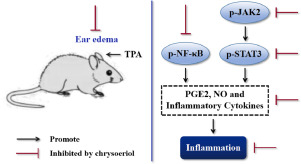当前位置:
X-MOL 学术
›
Phytomedicine
›
论文详情
Our official English website, www.x-mol.net, welcomes your
feedback! (Note: you will need to create a separate account there.)
Chrysoeriol ameliorates TPA-induced acute skin inflammation in mice and inhibits NF-κB and STAT3 pathways.
Phytomedicine ( IF 6.7 ) Pub Date : 2020-01-19 , DOI: 10.1016/j.phymed.2020.153173 Jia-Ying Wu 1 , Ying-Jie Chen 1 , Lu Bai 1 , Yu-Xi Liu 1 , Xiu-Qiong Fu 1 , Pei-Li Zhu 1 , Jun-Kui Li 1 , Ji-Yao Chou 1 , Cheng-Le Yin 1 , Ya-Ping Wang 1 , Jing-Xuan Bai 1 , Ying Wu 1 , Zheng-Zhi Wu 2 , Zhi-Ling Yu 3
Phytomedicine ( IF 6.7 ) Pub Date : 2020-01-19 , DOI: 10.1016/j.phymed.2020.153173 Jia-Ying Wu 1 , Ying-Jie Chen 1 , Lu Bai 1 , Yu-Xi Liu 1 , Xiu-Qiong Fu 1 , Pei-Li Zhu 1 , Jun-Kui Li 1 , Ji-Yao Chou 1 , Cheng-Le Yin 1 , Ya-Ping Wang 1 , Jing-Xuan Bai 1 , Ying Wu 1 , Zheng-Zhi Wu 2 , Zhi-Ling Yu 3
Affiliation

|
BACKGROUND
Chrysoeriol is a flavone found in diverse dietary and medicinal herbs such as Lonicerae Japonicae Flos (the dried flower bud or newly bloomed flower of Lonicera japonica Thunb.). These herbs are commonly used for treating inflammatory diseases. Herbal extracts containing chrysoeriol have been shown to have anti-inflammatory effects and inhibit nuclear factor-kappa B (NF-κB) signaling. Some of these extracts can inhibit signal transducers and activators of transcription 3 (STAT3) signaling in cancer cells.
PURPOSE
This study aimed to determine whether chrysoeriol has anti-inflammatory effects and whether NF-κB and STAT3 pathways are involved in the effects.
STUDY DESIGN AND METHODS
A TPA (12-O-tetradecanoylphorbol-13-acetate)-induced ear edema mouse model and LPS-stimulated RAW264.7 cells were used to evaluate the effects of chrysoeriol. Griess reagent was used to measure the production of nitric oxide (NO). Western blot and enzyme-linked immunosorbent assays were employed to detect protein levels. RT-qPCR analyses were used to detect mRNA levels. Haematoxylin and eosin (H&E) staining was employed to examine the pathological conditions in animal tissues.
RESULTS
In the mouse model, chrysoeriol ameliorated acute skin inflammation, evidenced by reduced ear thickness, ear weight and number of inflammatory cells in inflamed ear tissues. The compound lowered protein levels of phospho-p65 (Ser536), phospho-STAT3 (Tyr705), inducible nitric oxide synthases (iNOS), cyclooxygenase-2 (COX-2), interleukin 6 (IL-6), IL-1β and tumor necrosis factor α (TNF-α) in mouse swollen ears. In LPS-stimulated RAW264.7 cells, chrysoeriol also lowered levels of these proteins. In addition, chrysoeriol decreased the production of NO and prostaglandin E2; inhibited the phosphorylation of inhibitor of κB (Ser32), p65 (Ser536) and Janus kinase 2 (Tyr1007/1008); decreased nuclear localization of p50, p65 and STAT3; and down-regulated mRNA levels of pro-inflammatory cytokines IL-6, IL-1β and TNF-α that are transcriptionally regulated by NF-κB and STAT3 in the cell model.
CONCLUSION
We for the first time demonstrated that chrysoeriol ameliorates TPA-induced ear edema in mice, and that inhibition of JAK2/STAT3 and IκB/p65 NF-κB pathways are involved in the anti-inflammatory effects of chrysoeriol. This study provides chemical and pharmacological justifications for the use of chrysoeriol-containing herbs in treating inflammatory diseases, and provides pharmacological groundwork for developing chrysoeriol as a novel anti-inflammatory agent.
中文翻译:

雌三醇可改善TPA诱导的小鼠急性皮肤炎症,并抑制NF-κB和STAT3途径。
背景技术绿豆酚是在多种饮食和药用植物中发现的黄酮,例如金银花(Lonicerae Japonicae Flos)(金银花的干燥花芽或新盛开的花)。这些草药通常用于治疗炎症。含有金鸡油的草药提取物已显示出抗炎作用,并抑制核因子-κB(NF-κB)信号传导。这些提取物中的某些可抑制癌细胞中的信号转导子和转录3(STAT3)信号转导激活剂。目的本研究旨在确定金鸡油酚是否具有抗炎作用以及NF-κB和STAT3途径是否参与该作用。研究设计和方法TPA(12-O-十四烷酰phorbol-13-乙酸盐)诱导的小鼠耳水肿模型和LPS刺激的RAW264。7个细胞被用来评估金鸡油的效果。使用格里斯试剂测量一氧化氮(NO)的产生。使用蛋白质印迹法和酶联免疫吸附测定法检测蛋白质水平。RT-qPCR分析用于检测mRNA水平。苏木精和曙红(H&E)染色用于检查动物组织中的病理状况。结果在小鼠模型中,金鸡油可减轻急性皮肤炎症,这可通过降低耳朵的厚度,减轻耳朵的重量以及减轻发炎的耳组织中炎性细胞的数量来证明。该化合物降低了磷酸化p65(Ser536),磷酸化STAT3(Tyr705),诱导型一氧化氮合酶(iNOS),环氧合酶2(COX-2),白介素6(IL-6),IL-1β和肿瘤的蛋白质水平小鼠耳朵肿胀中的坏死因子α(TNF-α)。在LPS刺激的RAW264.7细胞中,金绿宝石油还降低了这些蛋白质的水平。此外,金鸡油醇可减少NO和前列腺素E2的产生。抑制κB(Ser32),p65(Ser536)和Janus激酶2(Tyr1007 / 1008)抑制剂的磷酸化;p50,p65和STAT3的核定位降低;细胞模型中由NF-κB和STAT3转录调节的促炎细胞因子IL-6,IL-1β和TNF-α的mRNA水平下调。结论我们首次证明了金刚玉酚改善了TPA诱导的小鼠耳部水肿,并且抑制JAK2 / STAT3和IκB/ p65NF-κB通路参与了金刚玉酚的抗炎作用。这项研究提供了化学和药理学依据,证明使用含金鸡油酚的草药治疗炎性疾病,
更新日期:2020-01-21
中文翻译:

雌三醇可改善TPA诱导的小鼠急性皮肤炎症,并抑制NF-κB和STAT3途径。
背景技术绿豆酚是在多种饮食和药用植物中发现的黄酮,例如金银花(Lonicerae Japonicae Flos)(金银花的干燥花芽或新盛开的花)。这些草药通常用于治疗炎症。含有金鸡油的草药提取物已显示出抗炎作用,并抑制核因子-κB(NF-κB)信号传导。这些提取物中的某些可抑制癌细胞中的信号转导子和转录3(STAT3)信号转导激活剂。目的本研究旨在确定金鸡油酚是否具有抗炎作用以及NF-κB和STAT3途径是否参与该作用。研究设计和方法TPA(12-O-十四烷酰phorbol-13-乙酸盐)诱导的小鼠耳水肿模型和LPS刺激的RAW264。7个细胞被用来评估金鸡油的效果。使用格里斯试剂测量一氧化氮(NO)的产生。使用蛋白质印迹法和酶联免疫吸附测定法检测蛋白质水平。RT-qPCR分析用于检测mRNA水平。苏木精和曙红(H&E)染色用于检查动物组织中的病理状况。结果在小鼠模型中,金鸡油可减轻急性皮肤炎症,这可通过降低耳朵的厚度,减轻耳朵的重量以及减轻发炎的耳组织中炎性细胞的数量来证明。该化合物降低了磷酸化p65(Ser536),磷酸化STAT3(Tyr705),诱导型一氧化氮合酶(iNOS),环氧合酶2(COX-2),白介素6(IL-6),IL-1β和肿瘤的蛋白质水平小鼠耳朵肿胀中的坏死因子α(TNF-α)。在LPS刺激的RAW264.7细胞中,金绿宝石油还降低了这些蛋白质的水平。此外,金鸡油醇可减少NO和前列腺素E2的产生。抑制κB(Ser32),p65(Ser536)和Janus激酶2(Tyr1007 / 1008)抑制剂的磷酸化;p50,p65和STAT3的核定位降低;细胞模型中由NF-κB和STAT3转录调节的促炎细胞因子IL-6,IL-1β和TNF-α的mRNA水平下调。结论我们首次证明了金刚玉酚改善了TPA诱导的小鼠耳部水肿,并且抑制JAK2 / STAT3和IκB/ p65NF-κB通路参与了金刚玉酚的抗炎作用。这项研究提供了化学和药理学依据,证明使用含金鸡油酚的草药治疗炎性疾病,











































 京公网安备 11010802027423号
京公网安备 11010802027423号